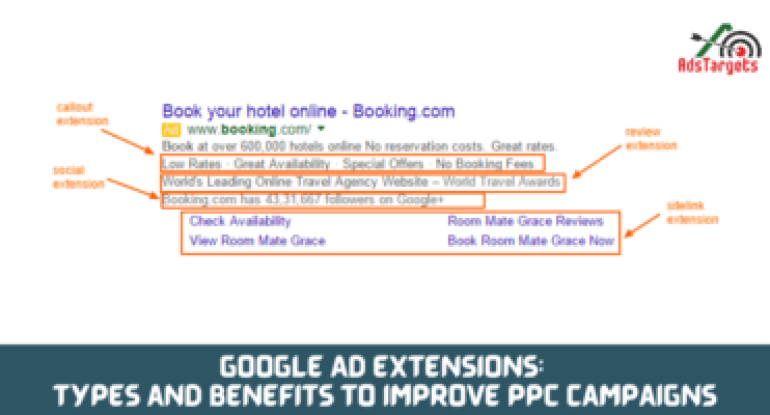Updated 16/05/2025
If you have run Google text ads before, you might notice how they have character limitations. It can be challenging to convey your message to the audience with such character restrictions placed in the algorithm to supervise your content outing.
It is like being given five 15 seconds to summarise a 15 minutes speech, that is how tough it used to be.
However, with the introduction of Google ads extensions, it has become possible and convenient for brand owners to convey their message clearly and include multiple CTAs for customers to engage with them.
Google Ad extensions allow you to add additional information about your brand or product to help the target consumer make informed decisions. These extensions stretch your ads by taking up more space on the search engine result pages.
There is so much to learn about Google ads extensions and this guide holds all the information within it, so if you will like to know more, then you are welcome to walk the road with me.
Table of Contents
ToggleWhat are Google Ads Extensions?
Google Ad extensions are extra chunks of information that you can show alongside your ads to deliver a complete message to your target audience.
They can contain links to particular subpages on your webpage, a call to action button, product pricing information, and more.

Why should you use Google Ads Extensions?
As I mentioned earlier, you can provide more information leveraging ad extensions, and your visibility on the Search engine result page is improved.
Try searching for a random keyword on your device, if the ad shown in the first position has added the extensions, you can notice that the entire screen is occupied by that one ad, and to see the next ad listed down, you will need to scroll down.
Did you see what the ad extensions are doing to the competitors?
It’s occupying the additional space pushing down the competitors from your sight until more effort is put into scrolling further down.
That’s cool, right? Yeah, I think every marketer should love this one.
On the whole, your lead quality gets enhanced, with better ad ranking when you use Google ads extensions.
Google Ad Extensions Types
#1. Location Extensions
As the name implies, this extension lists the location allowing people to find you using your location.
This helps enhance your legitimacy among your target consumers as they know where your physical store is.
#2. Sitelink Extensions
Instead of pointing the users to the landing page, you can now with the help of the site link extension, offer more options to the users and let them decide where they wish to land on your website.
You can add links to your contact page, testimonial page, product page, and more.
So, when users find exactly what they need, there is a high chance of improved click-through rates (CTR).
#3. Callout Extensions
With this extension, you can spotlight the significant selling points or main points about your product or service. Each point should be 25 characters max.
#4. Call Extensions
This extension applies to mobile devices. With this extension, you can include a clickable phone number in your ads. It allows the user to make calls to your business directly from the ad.
#5. Price Extensions
With price extension, you can establish transparency by setting cost expectations upfront for your users.
Therefore, you only drive users that fit in with your product price and avoid getting unwanted clicks that won’t lead to purchases.
For instance, some of the users might be interested in what you are selling but their purse depth might be lower than what you have set for your product.
By using the price extensions, you can filter out users with budget constraints from those who can afford to patronize your business.
#6. Lead form Extensions
This Google ad extension was rolled out in 2019. It enables users to submit their contact details from the search engine result page (SERP) itself rather than filling in a contact form on a landing page.
#7. Promotion Extensions
Promotion extension can add more value to your Search Network text ads by spotlighting your sales and promotions for people that are searching for the best deals your brand has to offer
It enables you to add a small piece of text with information about your store’s promotions as well as a link to your final URL placed close to the bottom of your ad.
#8. App Extensions
An app extension allows you to extend custom functionality and content beyond your app and make it available to users while they are interacting with other apps or the system. You create an app extension to allow a specific task.
#9. Structured snippet Extensions
Structured snippets are assets that spotlight specific aspects of your products and services. Structured snippets show beneath your text ad in the form of a header (for instance “Destinations”) and list of values (for instance: “Hawaii, Costa Rica, South Africa”)
They allow advertisers to describe features of a particular product or describe the range of products their business offers.
#10. Seller Rating Extensions
This extension type showcases your business’s reputation and builds trust.
Google gathers ratings from reputable business review websites and accumulates them into a single rating on a five-star scale.
This extension displays your overall rating, as well as the total number of reviews. They also sometimes include a qualifier to describe the rating.
How To Create Google Ads Extensions
Now that you know more about the various types of Google Ads extensions and how they can work for you, let’s take a look at how to create them.
The first thing you need to do is decide your goals and which extensions will work best with your goals.
Do you want your customers to contact you? Submit their contact information? Visit your website?
Figure out what you want your targets to do, and then select the extension that encourages that.
With that phase figured out, the next phase is a smooth linear road:
#1. Log into your Google Ads platform.
#2. Choose your campaign or ad group.
#3. Click the “Ads and extensions” tab, then hit “Extensions.”
#4. Choose the extension(s) type you want.
#5. Customize each type of extension.
#6. Click Save
Conclusion
If your marketing goal is to enhance the Click-through rate (CTR), drive quality leads, and convert more leads, then Google ads extensions are an amazing tool to pick up and score these goals with.
But first, you need to pick the right ad extensions that best suit your business, this guide has touched on the different types of extensions, just make sure you pick the one that suits your goal and you are good to go.
I hope this helps, good luck.








